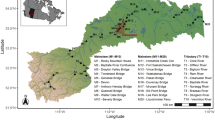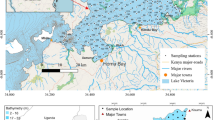Abstract
Background, aim and scope
A new method using sedimentary metals and geographic information system as indicators for assessing temporal and spatial anthropogenic change in estuaries has been applied to a large coastal lake (Lake Macquarie) in New South Wales, Australia.
Materials, methods and results
Two vintages of data (1975 and 2003) on surficial sediment metal (Cd, Cu, Pb and Zn) concentrations combined with 210Pb core profiles were used to determine past changes in sediment quality and to predict possible future relaxation rates for the entire lake area in response to change in anthropogenic pressure. Sediment cores showed distinct vertical profiles; sedimentation rates in the northern part of the lake were consistent (14 mm year−1) over the 55-year period investigated.
Discussion and conclusions
Surficial metal concentrations were highest in the 1975 sediment than in the 2003 samples, with the northern part of Lake Macquarie having much greater metal concentrations than the rest of the lake. Past and future declining sedimentary metal concentrations in the northern part of the lake were expected due to the closure of a nearby Pb–Zn smelter; however, possible increases in Cu in the south of the lake to the year 2020 were surprising. The new method presented in this study can assist estuary managers by providing data on past, present and future conditions, which are essential in making informed decisions for the improvement of estuarine systems.














Similar content being viewed by others
References
Abril JM (2003) A new theoretical treatment of compaction and the advective–diffusive processes in sediments: a reviewed basis for radiometric dating models. J Paleolimnol 30:363–370
ANZECC/ARMCANZ (2000) Australian and New Zealand guidelines for fresh and marine water quality. Australian and New Zealand Environmental Conservation Council and Agriculture and Resource Management Council of Australia and New Zealand, Artarmon, NSW
Appleby PG (2001) Chronostratigraphic techniques in recent sediments. In: Last WM, Smol JP (eds) Tracking environmental change using lake sediments, vol 1: basin analysis, coring and chronological techniques. Kluwer, Dordrecht, pp 171–203
Backer H (2008) Indicators and scientific knowledge in regional Baltic Sea environmental policy. ICES J Mar Sci 65:1398–1401
Barbanti A, Bothner MH (1993) A procedure for partitioning bulk sediments into distinct grain-size fractions for geochemical analysis. Environ Geol 21:3–13
Batley GE (1987) Heavy metal speciation in waters, sediments and biota from Lake Macquarie, NSW. Aust J Mar Freshwat Res 38:591–660
Bayer E, Barnes RA, Rees HL (2008) The regulatory framework for marine dredging indicators and their operational efficiency within the UK: a possible model for other nations? ICES J Mar Sci 65:1402–1406
Belpaire C, Goemans G, Geeraerts C, Quataert P, Parmentier K (2008) Pollution fingerprints in eels as models for the chemical status of rivers. ICES J Mar Sci 65:1483–1491
Birch GF (2003) A test of normalisation methods for marine sediments, including a new post-extraction normalisation (PEN) technique. Hydrobiologia 492:5–13
Birch GF, Taylor SE (2000) The use of size-normalisation procedures in the analysis of organic contaminants in estuarine environments. Hydrobiologia 431:129–133
Birch GF, Olmos MA (2008) Sediment-bound heavy metals as indicators of human influence and biological risk in coastal water bodies. ICES J Mar Sci 65:1407–1413
Clarke CSLM, Roff JC, Bard SM (2008) Back to the future: using landscape ecology to understand changing patterns of land use in Canada, and its effects on the sustainability of coastal ecosystems. ICES J Mar Sci 65:1534–1539
DNR (1999) Estuaries of NSW, Lake Macquarie. Department of Natural Resources NSW. Available via http://www.naturalresources.nsw.gov.au/estuaries/inventory/macquarie.shtml. Accessed 14 Sept 2009
ESRI (2001) ArcGIS v9. Using ArcGIS geostatistical analyst. ESRI, Redlands
Fernandez-Torquemada Y, Diaz-Valdes M, Colilla F, Luna B, Sanchez-Lizaso JL, Ramos-Espla AA (2008) Descriptors from Posidonia oceanica (L.) Delile meadows in coastal waters of Valencia, Spain, in the context of the EU Water Framework Directive. ICES J Mar Sci 65:1492–1497
Gale SJ, Haworth RJ, Pisanu PC (1995) The 210Pb chronology of late Holocene deposition in an eastern Australian lake basin. Quatern Sci Rev 14:395–408
Goldberg ED (1963) Geochronology with lead-210. In: Radioactive dating. IAEA, Vienna, pp 121–131
Harrison J, Heijnis H, Caprarelli G (2003) Historical pollution variability from abandoned mine sites, Greater Blue Mountains World Heritage Area, New South Wales, Australia. Environ Geol 43:680–687
Haworth RJ, Gale SJ, Short SA, Heijnis H (1999) Land use and lake sedimentation on the New England tablelands of New South Wales, Australia. Aust Geogr 30:51–73
He Q, Walling DE (1996) Interpreting particle size effects in the adsorption of 137Cs and unsupported 210Pb by mineral soils and sediments. J Environ Radioactiv 30:117–137
Kilby GW, Batley GE (1993) Chemical indicators of sediment chronology. Aust J Mar Freshwat Res 44:635–647
Laissaoui A, Benmansour M, Ziad N, Ibn Majah M, Abril JM, Mulsow S (2008) Anthropogenic radionuclides in the water column and a sediment core from the Alboran Sea: application to radiometric dating and reconstruction of historical water column radionuclide concentrations. J Paleolimnol 40:823–833
Lake Macquarie Council (1985) Lake Macquarie: past and present. Lake Macquarie City Council, Boolaroo, NSW
LeMarie M, van der Zaag P, Menting G, Baquete E, Schotanus D (2006) The use of remote sensing for monitoring environmental indicators: the case of the Incomati estuary, Mozambique. Phys Chem Earth 31:857–863
Li C, Walker N, Hou A, Georgiou I, Roberts H, Laws E, McCorquodale JA, Weeks E, Li X, Crochet J (2008) Circular plumes in Lake Pontchartrain estuary under wind straining. Estuar Coast Shelf Sci 80:161–172
Loring DH, Rantala RTT (1992) Manual for the geochemical analyses of marine sediments and suspended particulate matter. Earth-Sci Rev 32:235–283
Moreno M, Vezzulli L, Marin V, Laconi P, Albertelli G, Fabiano M (2008) The use of meiofauna diversity as an indicator of pollution in harbours. ICES J Mar Sci 65:1428–1435
Nelson WG, Brown CA (2008) Use of probability-based sampling of water-quality indicators in supporting development of quality criteria. ICES J Mar Sci 65:1421–1427
Oldfield F, Appleby PG (1984) Empirical testing of 210Pb-dating models for lake sediments. In: Hayworth EY, Lund JWG (eds) Lake sediments and environmental history. Leicester University Press, Leicester, pp 93–124
Parsons M, Mitchell I, Butler A, Ratcliffe N, Frederiksen M, Foster S, Reid JB (2008) Seabirds as indicators of the marine environment. ICES J Mar Sci 65:1520–1526
Pringle G (1975) Lake Macquarie environmental plan. Lake Macquarie Shire Council, New South Wales
Putyrskaya V, Klemt E (2007) Modeling 137Cs migration processes in lake sediments. J Environ Radioactiv 96:54–62
Roach AC (2005) Assessment of metals in sediment from Lake Macquarie, New South Wales, Australia, using normalisation models and sediment quality guidelines. Mar Environ Res 59:453–472
Roy PS, Peat C (1975) Bathymetry and bottom sediments of Lake Macquarie. Rec Geol Surv NSW 17:53–64
Roy PS, Crawford EA (1984) Heavy metals in a contaminated Australian estuary—dispersion and accumulation trend. Estuar Coast Shelf Sci 19:341–358
Ryan SA, Roff JC, Yeats PA (2008) Development and application of seasonal indices of coastal-zone eutrophication. ICES J Mar Sci 65:1469–1474
Siciliano D, Wasson K, Potts DC, Olsen RC (2008) Evaluating hyperspectral imaging of wetland vegetation as a tool for detecting estuarine nutrient enrichment. Remote Sensing of Environment 112:4020–4033
Simpson SL, Batley GE, Chariton AA, Stauber JL, King CK, Chapman JC, Hyne RV et al (2005) Handbook for sediment quality assessment. CSIRO, Bangor, NSW
Spurway R (1982) Heavy metals in the sediments of Cockle Creek. Occasional Paper No. 31, Department of Geography, R.M.C., Duntroon, A.C.T. 2600, Australia
Taylor SE, Birch GF, Links F (2004) Historical catchment changes and temporal impact on sediment of the receiving basin, Port Jackson, New South Wales. Aust J Earth Sci 51:233–246
USEPA (1991) Methods for the determination of metals in environmental samples. Environmental Monitoring Systems Laboratory, Office of Research and Development EPA-600/4-91-010
Walling DE, He Q, Appleby PG (2002) Conversion models for use in soil-erosion, soil-redistribution and sedimentation investigations. In: Zapata F (ed) Handbook for the assessment of soil erosion and sediment using environmental radionuclides. Kluwer, Dordrecht, pp 111–164
Willmore A, Sladden T, Bates L, Dalton CB (2006) Use of a geographic information system to track smelter-related lead exposures in children: North Lake Macquarie, Australia, 1991–2002. International Journal of Health Geographics 5:30
Acknowledgements
We thank Lake Macquarie City Council and the Australian Nuclear Science and Technology Organisation (ANSTO, AINSE grant/ref. no. AINGRA07013) for financial support for this project. Datasets used included 1:100,000 and 1:250,000 topographic maps from Geoscience Australia and the New South Wales Department of Natural Resources.
Author information
Authors and Affiliations
Corresponding author
Additional information
Responsible editor: Zhihong Xu
Rights and permissions
About this article
Cite this article
Olmos, M.A., Birch, G.F. A novel method using sedimentary metals and GIS for measuring anthropogenic change in coastal lake environments. Environ Sci Pollut Res 17, 270–287 (2010). https://doi.org/10.1007/s11356-009-0250-1
Received:
Accepted:
Published:
Issue Date:
DOI: https://doi.org/10.1007/s11356-009-0250-1




